
A look at one of the author's top steel target picks: the Action Target PT Hostage.
My education and adventures with the defensive handgun really began when I became a police officer almost 30 years ago. At that time, the most popular target used in law enforcement was the B27. The B27 target is a life-size black silhouette of a man, and inside the silhouette are five oval scoring rings. Typically, this target was used for qualification, but because police departments hate to spend money, it also became the de facto practice target.
As I became involved in combat pistol competitions, I was introduced to the IPSC target. The common IPSC target is a carboard target measuring 30 inches tall by 18 inches wide. It’s shaped to replicate a human torso and head, and it also has scoring rings—squares and rectangles—in the torso and head regions. The IPSC target is a bit more practical than the B27 target, and it typically has a white and a brown side. Because it’s cardboard, it’s much easier to work with … and it lasts longer.
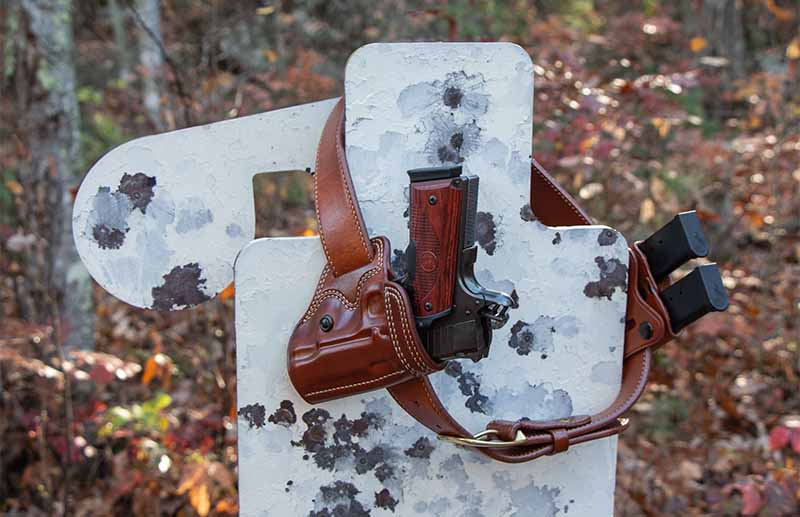
But in combat pistol competitions, whether IPSC sanctioned or not, steel targets started becoming very popular. The old standby steel target was the pepper popper. Though now offered in various sizes, originally it was about 42 inches tall and based around a center 12-inch circle to replicate a torso, with skinny legs and a head section as well. When you shoot the pepper popper, it falls over, and it can be adjusted so a head shot is required to knock it down—or even adjusted so that a .45 ACP will knock it down, but a 9mm will not.
Other steel targets were and are used as well for competition. These are generally small circles or squares that’ll fall over when shot. Fortunately, back in the day, many local ranges purchased pepper poppers and other steel plates for matches, and members could use them when practicing. I even managed to convince my department to buy a few steel targets. However, the downside to all these targets was that, after you shot them, you had to walk downrange and reset them. This, of course, slowed matches, training and practice.
As competitive combat pistol and three-gun shooting competitions continued to grow in popularity, the availability and variety of steel targets dramatically increased. By the time I left law enforcement in 2005, the types of steel targets being used were beginning to defy the imagination. Not only were there several companies making them, but the prices were also reasonable enough so the average guy could afford one … or several.
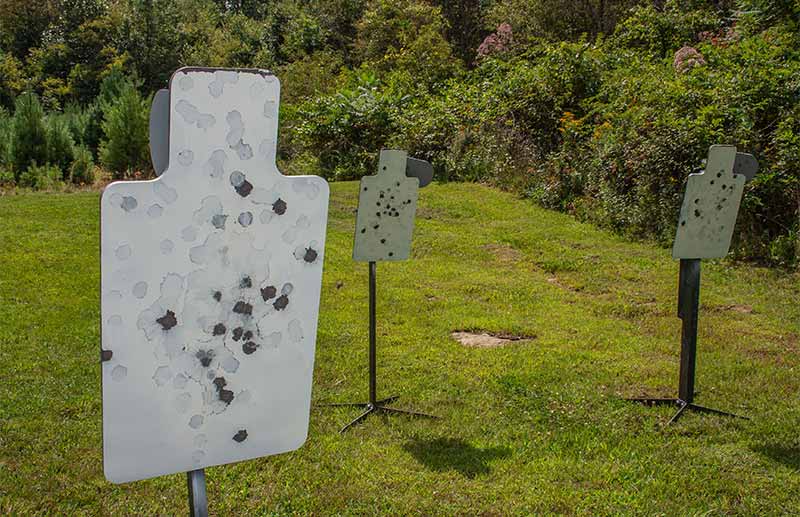
Finding The One
I talked to several manufacturers and conducted a lot of research about steel targets before I spent any money. If I was going to spend several hundred bucks, I wanted to make sure I got my money’s worth. Not only did I want a target that’d be beneficial to my defensive handgun training, but I also wanted a target I could shoot with a rifle. This meant it needed to be constructed of AR550 steel. My other requirements were that it be reactive, and that I wouldn’t have to walk downrange to reset it.
Ultimately, I settled on the Action Target PT Hostage Target. This is an AR550 steel target that’s shaped sort of like a human torso. With a 3-foot base, it stands about 5 feet tall, with a target face measuring 24 inches tall (including the head section) and 13 inches wide. It also has a swinging 6-inch plate that flops to either side of the head section when the plate is hit. The target only weighs about 60 pounds. For handguns, the recommended safe shooting distance is 10 yards; for rifles, it’s 100.
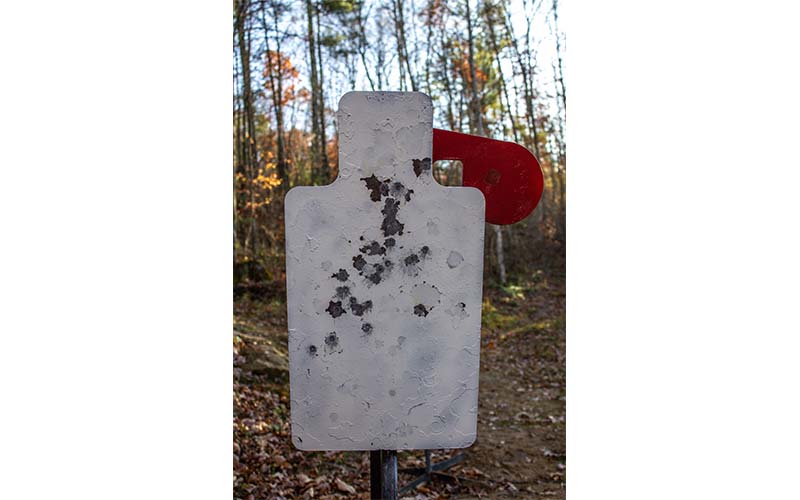
But one of the unique features of this target is that it’s mounted at an angle, so it’s slightly facing toward the ground. There are also no bolt heads or weld seems on the target face. This means the splash from bullet impact is cleanly forced almost straight down. Though Action Target doesn’t recommend it, I’ve shot these targets as close as 3 yards with a handgun with no issue whatsoever. With rifles producing muzzle velocities less than 2,500 fps, I’ve also found it safe to shoot at 50 yards.
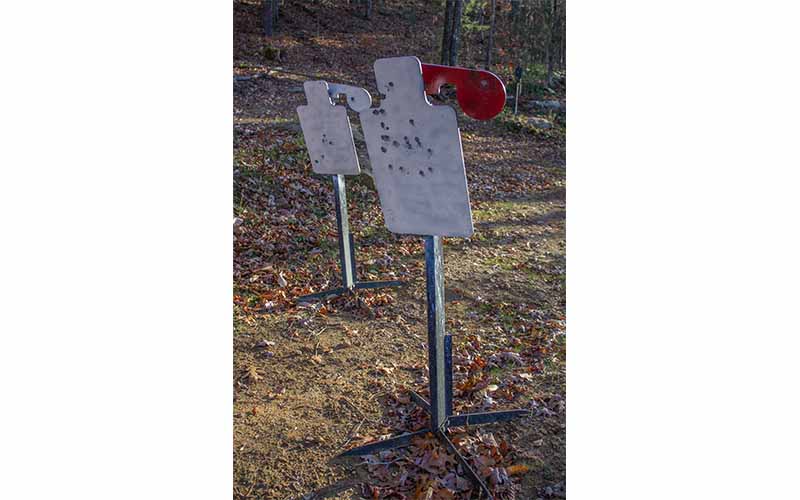
This target is ideal for just about any type of defensive handgun drill—you can paint the target face any way you like—and the swinging head plate allows you to be creative with the drills you come up with. (Action target also offers two small swinging steel plates for a pelvic hit zone for an additional $89.)
I liked the target so much I ended up getting three more, and over the span of what’s now been 10 years, I couldn’t fathom a guess as to how many handgun and rifle rounds these targets have stopped. The only maintenance they’ve ever required was painting, and they’re still as good as new.
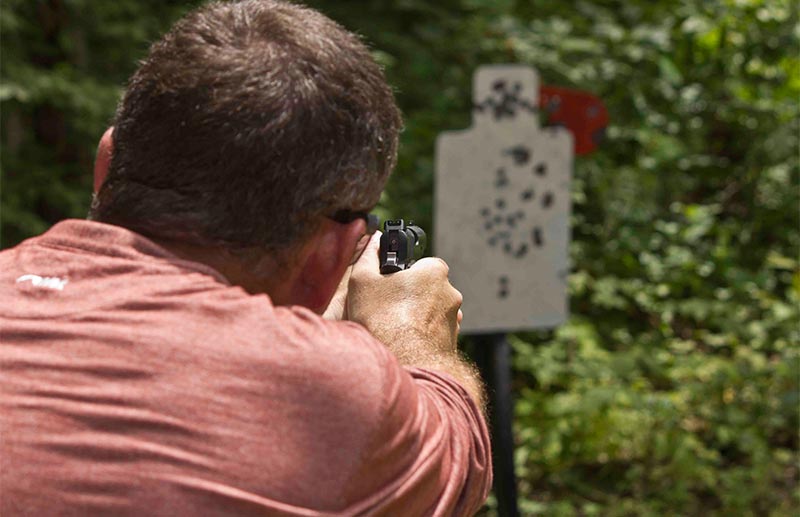
Clearly, the advantage of these targets is that you get immediate feedback when you shoot. You’ll see the headplate flop to the other side, the target wiggle, hear the ring of the steel and, if the paint is fresh, you’ll also see the point of impact. All this combined with not having to go down range and tape bullet holes or reset steel increases the enjoyment of the training session and the quality of the training.
I’d strongly urge anyone with their own place to shoot to consider the purchase of some steel targets. I’d also suggest that the first steel target purchased be the Action Target PT Hostage Target. With a 3-foot stand, they retail for $352 and you can order direct from Action Target.
Like mine, it should last 10 years or more—that’s only about $35 a year. A box of 100 cardboard IPSC targets costs about $70, and you’ll run through ’em pretty fast, not to mention the stapler and staples you’ll need, and the trash they’ll create.
For more information, please visit actiontarget.com.
Editor's Note: This article originally appeared in the July 2021 issue of Gun Digest the Magazine.
More On Target Selection:
- 5 Best Steel Targets
- Why You Should Shoot AR500 Targets
- The Best Pistol Targets For Handgun Training
- Choosing The Right Targets For You

Next Step: Get your FREE Printable Target Pack
Enhance your shooting precision with our 62 MOA Targets, perfect for rifles and handguns. Crafted in collaboration with Storm Tactical for accuracy and versatility.
Subscribe to the Gun Digest email newsletter and get your downloadable target pack sent straight to your inbox. Stay updated with the latest firearms info in the industry.

![Best Concealed Carry Guns In 2025 [Field Tested] Wilson Combat EDC X9S 1](https://gundigest.com/wp-content/uploads/Wilson-Combat-EDC-X9S-1-324x160.jpg)


![Best 9mm Carbine: Affordable PCCs [Tested] Ruger Carbine Shooting](https://gundigest.com/wp-content/uploads/Ruger-Carbine-Shooting-100x70.jpg)
![Best AR-15: Top Options Available Today [Field Tested] Harrington and Richardson PSA XM177E2 feature](https://gundigest.com/wp-content/uploads/Harrington-and-Richardson-PSA-XM177E2-feature-100x70.jpg)

Just a personal note from experience. That picture showing the shooter engaging the steel plate is standing too close. Rounds can and will fly straight back at that range if they encounter a bump to redirect it. Things like bullet impact dents can do that so do be careful. I caught a 158 pure lead from a 2” smith in the shoulder at that range. It didn’t hole my Capeharts and was more like a punch but I sure wouldn’t want to get one in the neck .
Since then I keep mine ground Flat and hung so it tips 15 degrees back at the bottom. That helps give them some place to go reliably… with less splatter